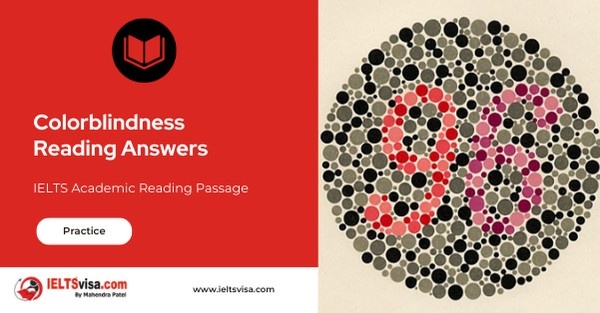Colorblindness Reading Answers
IELTS Academic Reading Passage
A Myths related to the causes and symptoms of “colorblindness” abound throughout the world. The term itself is misleading, since it is extremely rare for anyone to have a complete lack of color perception. By look ing into the myths related to color blindness, one can learn many facts about the structure and genetics o the human eye. It is a myth that colorblind people see the world as if it were a black and white movie. There are very few cases of complete colorblindness. Those who have a complete lack of color perception are referred to as monochromatics, and usually have a serious problem with their overall vision as well as an inability to see colors. The fact is that in most cases of colorblindness, there are only certain shades that a person cannot distinguish between. These people are said to be dichromatic. They may not be able to tell the difference between red and green, or orange and yellow. A person with normal color vision has what is called trichromatic vision. The difference between the three levels of color perception have to do with the cones in the human eye. A normal human eye has three cones located inside the retina: the red cone, the green cone, and the yellow cone. Each cone contains a specific pigment whose function is to absorb the light of these colors and the combinations of them. People with trichromatic vision have all three cones in working order. When one of the three cones does not function properly, dichromatic vision occurs.
B Some people believe that only men can be colorblind. This is also a myth, though it is not completely untrue. In an average population, 8% of males exhibit some form of colorblindness, while only 0.5% of women do. While there may be some truth to the idea that more men have trouble matching their clothing than women, the reason that color vision deficiency is predominant in males has nothing to do with fashion. The fact is that the gene for color blindness is located on the X chromosome, which men only have one of. Females have two X chromosomes, and if one carries the defective gene, the other one naturally compensates. Therefore, the only way for a female to inherit colorblindness is for both of her X chromosomes to carry the defective gene. This is why the incidence of color deficiency is sometimes more prevalent in extremely small societies that have a limited gene pool.
C It is true that all babies are born colorblind. A baby’s cones do not begin to differentiate between many different colors until he is approximately four months old. This is why many of the modern toys for very young babies consist of black and white patterns or primary colors, rather than traditional soft pastels. However, some current research points to the importance of developing an infant’s color visual system. In 2004, Japanese researcher Yoichi Sugita of the Neuroscience Research Institute performed an experiment that would suggest that color vision deficiency isn’t entirely genetic. In his experiment, he subjected a group of baby monkeys to monochromatic lighting for one year. He later compared their vision to normal monkey who had experienced the colorful world outdoors. It was found that the test monkeys were unable to perform the color-matching tasks that the normal monkeys could. Nevertheless, most cases of colorblindness are attributed to genetic factors that are present at birth.
D Part of the reason there are so many inconsistencies related to colorblindness, or “color vision deficiency” as it is called in the medical world, is that it is difficult to know exactly which colors each human can see. Children are taught from a very young age that an apple is red. Naming colors allows children to associate a certain shade with a certain name, regardless of a color vision deficiency. Someone who never takes a color test can go through life thinking that what they see as red is called green. Children are generally tested for colorblindness at about four years of age. The Ishihara Test is the most common, though it is highly criticized’ because it requires that children have the ability to recognize numerals. In the Ishihara Test, a number made up of colored dots is hidden inside a series of dots of a different shade. Those with normal vision can distinguish the number from the background, while those with color vision deficiency will only see the dots.
E While many of the myths related to colorblindness have been busted by modern science, there are still a few remaining beliefs that require more research in order to be labeled as folklore. For example, there is a long-standing belief that colorblindness can aid military soldiers because it gives them the ability to see through camouflage. Another belief is that everyone becomes colorblind in an emergency situation. The basis of this idea is that a catastrophic event can overwhelm the brain, causing it to utilize only those receptors needed to perform vital tasks. In general, identifying color is not considered an essential task in a life or death situation.
Questions 1-5
The following reading passage has five sections A-E.
Choose the correct heading for each section from the list of headings.
Write the correct number i-viii in boxes 1-5 on your answer sheet.
NB. There are more headings than sections, so you will not use them all.
Buy bestselling books online
1 Section A
2 Section B
3 Section C
4 Section D
5 Section E
List of Headings
i Colorblindness’ in different countries
ii Diagnosing colorblindness
iii What is colorblindness?
iv Curing colorblindness
v Unsolved myths
vi Animals and colorblindness
vii Developing the ability to see color
viii Colorblindness and the sexes
Questions 6-8
Choose the correct letter, A, B, C, or D. Write your answers in boxes 6-8 on your Answer Sheet.
6 People who see color normally are called
A monochromatic.
B dichromatic.
C tichromatic.
D colorblind.
7 Children usually begin to see a variety of colors by the age of
A one month.
B four months.
C one year.
D four years.
8 Children who take the Ishihara Test must be able to
A distinguish letters.
B write their names.
C read numbers.
D name colors.
Questions 9-12
Complete the summary using words from the box below.
\Write your answers in boxes 9-12 on your Answer Sheet.
There are more answers than spaces, so you will not use them all.
It is a common 9 ……………….. that only men suffer from colorblindness. On average 10 ……………….. than ten percent of men have this problem. Women have two 11 ……………….. For this reason, it is 12 ……………….. for a woman to suffer from colorblindness.
|
myth a little less |

Solution For: Colorblindness
Reading Answers
| 1. iii | 2. viii |
| 3. vii | 4. ii |
| 5. v | 6. C |
| 7. B | 8. C |
| 9. myth | 10. a little less |
| 11. X chromosomes | 12. less likely |
Review and Practice
- Regularly practice with IELTS reading samples and time yourself to get used to the pressure of the exam.
- Review your mistakes to understand where you went wrong and how to avoid similar errors in the future.
Our Books
Master IELTS Speaking Part 1
IELTS Writing Task 1 Book
IELTS Writing Task 2 Book
Colorblindness Reading Answers Explanation
Comin Soon
Practice IELTS Other Modules
IELTS Listening
The IELTS Listening test assesses how well you can understand spoken English in various contexts. It lasts about 30 minutes and is divided into four sections with a total of 40 questions. The listening tasks become increasingly difficult as the test progresses.
IELTS Academic Reading
The IELTS Academic Reading section assesses your ability to understand and interpret a variety of texts in academic settings. It is designed to evaluate a range of reading skills, including skimming for gist, reading for main ideas, reading for detail, understanding inferences, and recognizing a writer's opinions and arguments.
IELTS Speaking
The IELTS Speaking test assesses your ability to communicate in English on everyday topics. It lasts 11-14 minutes and consists of three parts: introduction, cue card, and a discussion based on the cue card topic.
IELTS General Reading
IELTS General Reading tests your ability to understand and interpret various types of texts. Here are some key areas and types of content you can expect to encounter in the reading section, along with tips for effective preparation.
IELTS Academic Writing Task 1
In IELTS Academic Writing Task 1, you are presented with a visual representation of information, such as graphs, charts, tables, or diagrams, and you are required to summarize, compare, or explain the data in your own words.
IELTS General Writing Task 1
In IELTS General Writing Task 1, you are required to write a letter based on a given situation. The letter can be formal, semi-formal, or informal, depending on the prompt. Here’s a breakdown of the key components to include in your letter
IELTS Academic Writing Task 2
In IELTS Academic Writing Task 2, you are required to write an essay in response to a question or topic. Here’s a guide to help you understand the essential elements of this task
IELTS Exam Tips
To succeed in the IELTS exam, practice regularly, familiarize yourself with the test format, improve your vocabulary, develop time management skills, and take mock tests to build confidence.
Grammer for IELTS
Grammar is the foundation of effective communication in English. Understanding tense usage, subject-verb agreement, and sentence structure enhances clarity and coherence in writing and speaking.
Vocabulary for IELTS
Vocabulary plays a crucial role in the IELTS (International English Language Testing System) exam, especially in the Speaking and Writing sections. Here’s an overview of why vocabulary is important and how it impacts your performance
RECENT IELTS SAMPLES QUESTIONS AND ANSWERS
Back to the Future Skyscraper Design
A. “The Recovery of Natural Environments in Architecture” by Professor Alan Short represents...
UNMASKING SKIN
AIf you took off your skin and laid it flat, it would cover an area of about twenty-one square...
The World is Our Oyster Reading Answer
A. Independent travel is on the increase and while package holidays which offer an all...
Investigating Children’s Language
A For over 200 years, there has been an interest in the way children learn to speak and...
Why companies should welcome disorder
A Organisation is big business. Whether it is of our lives – all those inboxes and calendars –...
Saving bugs to find new drugs
A More drugs than you might think are derived from, or inspired by, compounds found in living...













